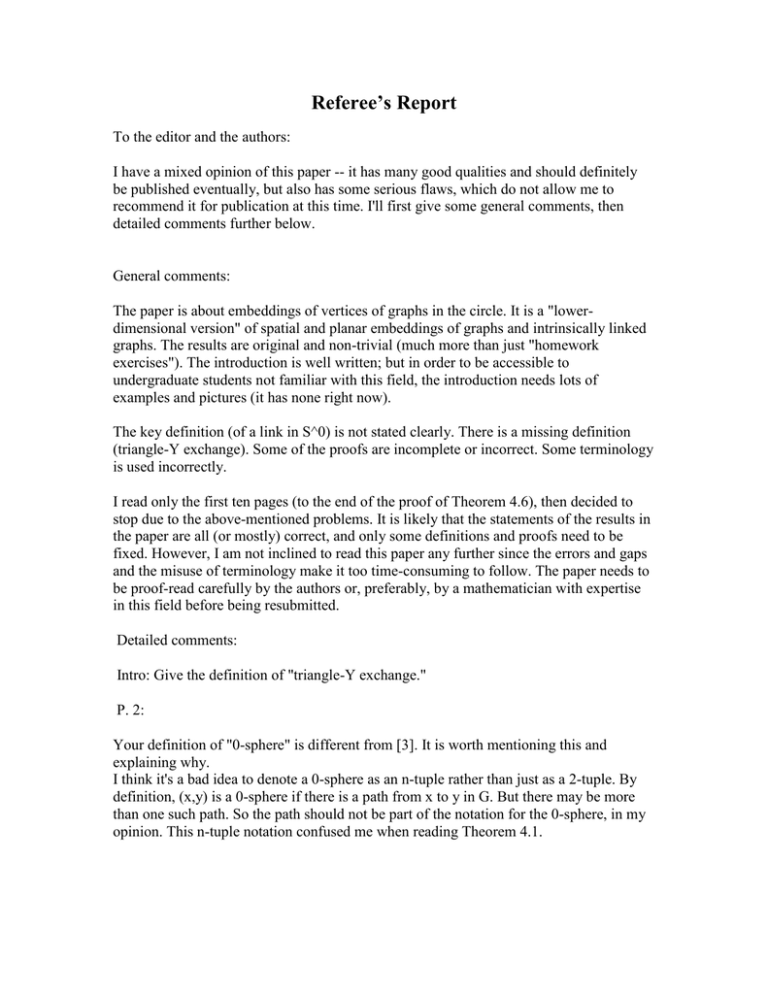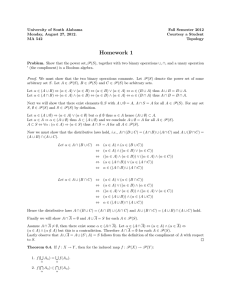Referee’s Report
advertisement

Referee’s Report
To the editor and the authors:
I have a mixed opinion of this paper -- it has many good qualities and should definitely
be published eventually, but also has some serious flaws, which do not allow me to
recommend it for publication at this time. I'll first give some general comments, then
detailed comments further below.
General comments:
The paper is about embeddings of vertices of graphs in the circle. It is a "lowerdimensional version" of spatial and planar embeddings of graphs and intrinsically linked
graphs. The results are original and non-trivial (much more than just "homework
exercises"). The introduction is well written; but in order to be accessible to
undergraduate students not familiar with this field, the introduction needs lots of
examples and pictures (it has none right now).
The key definition (of a link in S^0) is not stated clearly. There is a missing definition
(triangle-Y exchange). Some of the proofs are incomplete or incorrect. Some terminology
is used incorrectly.
I read only the first ten pages (to the end of the proof of Theorem 4.6), then decided to
stop due to the above-mentioned problems. It is likely that the statements of the results in
the paper are all (or mostly) correct, and only some definitions and proofs need to be
fixed. However, I am not inclined to read this paper any further since the errors and gaps
and the misuse of terminology make it too time-consuming to follow. The paper needs to
be proof-read carefully by the authors or, preferably, by a mathematician with expertise
in this field before being resubmitted.
Detailed comments:
Intro: Give the definition of "triangle-Y exchange."
P. 2:
Your definition of "0-sphere" is different from [3]. It is worth mentioning this and
explaining why.
I think it's a bad idea to denote a 0-sphere as an n-tuple rather than just as a 2-tuple. By
definition, (x,y) is a 0-sphere if there is a path from x to y in G. But there may be more
than one such path. So the path should not be part of the notation for the 0-sphere, in my
opinion. This n-tuple notation confused me when reading Theorem 4.1.
In your definition of a link (a,b) \union (c,d), it is not specified that there must exist
DISJOINT paths from a to b and from c to d. But I believe you do want them to be
disjoint – otherwise in a connected graph any two vertices form a 0-sphere.
P. 3:
I think I've heard that O'Donnol's result in [8] has changed: I think it may be
K_{2n,2n+1} instead of {K_2n,2n}. But I may have this all wrong. You should check
with the author.
Middle paragraph: "...at most two distinct faces whose boundaries contain all of the
vertices." Do you mean "each of whose boundaries" or "union of the boundaries?"
P. 4:
First paragraph: "... it is necessary to show that vertex expansion ..." No, it is not
necessary! The set is finite regardless (by [9]).
Proof of Theorem 2.1: It's missing Case 3: (w_1, ..., w_i, v) (i.e., v is an endpoint). This
case is different from the other two cases, and is important.
Also, this proof doesn't seem to explicitly have anything to do with the fact that these are
THREE-component links. It seems the proof will work for n-links. You should address
this point, either way.
You should mention that this proof is the same as the one in [3] (and you're obviously
borrowing from [3]) except that there is an additional case to check because the definiton
of "link" in this paper is different from that in [3] (not because it has anything to do with
3-links instead of 2-links, as far as I could tell). Be careful with whether the paths must
be disjoint or not.
P. 5:
In the proof of Theorem 3.1, define a,b,c,v. Also, don't use the same notation (a,b) for 0spheres and edges.
"… that results from deleting vertex v and …" : deleting v from the graph or from the
image of the embedding? Be clear. When you delete a vertex from a graph, you also
delete all edges incident with it, so the graph may become disconnected, which may
change things a lot.
The proof of Theorem 3.1 is incorrect or incomplete:
In Case 1, do you really mean 0-spheres by (a,b), (b,c), and (c,a) or do you mean edges?
If 0-spheres (which is what you write), then the proof is wrong, because paths matter; so I
assume you mean edges, in which case you must explain why after the triangle-Y
exchange the three links are still links (why do there still exist three DISJOINT paths?).
Also, in your definition of 0-sphere, you require SIMPLE paths. This makes the proof of
Case 2 more delicate, which you seem to have either missed or chosen to ignore. Why do
you require SIMPLE paths in your definition anyway? If you really do want this, then
you need more detail and care with the proof of Theorem 3.1.
Finally, this theorem and its proof don't seem to have much to do with THREE-links; I
think it should work for n-links as well; you should check this and comment on it.
Question: Does a Y-triangle exchange preserve S^1 linkedness? If you don't know the
answer, then I suggest posing it as a question.
Last sentence on this page: "It turns out that it does not preserve this property." Either
give a proof or take out this claim.
P. 6:
Proof of Theorem 3.2, Case 2: … "Then H' is a minor of G." Should prove this.
The paragraph right before Section 4 is very nice!
P. 7:
I think Theorem 4.1 should be called a lemma.
In the statement of Theorem 4.1, when you say disjoint 0-spheres, that only means
disjoint endpoints; do you really mean disjoint paths?
In the proof of Lemma 4.2, you should omit the 4 cases; they are obvious. After the first
paragraph, just say "So the lemma follows".
P. 10:
Proof of 4.6: When you "delete" the 0-sphere (a,b), do you delete both vertices or just
one? What if one of them (but not both) is involved in one of the three links? It's not clear
whether your proof addresses this scenario.
Later in the same proof: "Delete edge (a,b) from this embedding". This has no meaning -edges are not embedded; only vertices are. What do you really mean? Be careful and
precise with the terminology. The proof is incorrect or incomplete.
I got frustrated at this point and stopped reading any further. I know this whole report
sounds somewhat harsh; I hope I haven't discouraged you, though! You all have done an
awesome job; just check everything again very carefully and fix the errors and gaps and
the imprecise terminology. It has great potential.



